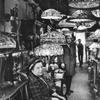Portrait Bust Is Discovered of A Remarkable Victorian Woman Activist By American Sculptor Margaret Foley
- LONDON, United Kingdom
- /
- June 22, 2021

A previously-unknown bust of a remarkable female Victorian activist, journalist, war correspondent, nurse, and a supporter and biographer of Garibaldi - Jessie White Mario (1832-1906) - attributed to the American sculptor Margaret Foley (c. 1827-1877), has been discovered by London art dealers Ben Elwes Fine Art.
The work goes on public view for the first time when offered for sale at London Art Week, July 2-16.
As well as supporting Garibaldi and Italian Unification, Jessie White Mario, who was born in Hampshire, England in 1832, protested against poverty and slavery, and made a stand for women’s rights in education: she applied to study medicine but was rejected by fourteen schools in London on the grounds of her sex. She wrote, ‘in no single case did I receive either a sensible or logical reply to my question, “Why may not a woman study medicine?”’. She instead found international acclaim as a journalist with audiences in Britain, America and Italy, was a loyal adherent to the Italian revolutionary leader Giuseppe Garibaldi (1807-1882) and authored his seminal biography of 1885.
She challenged the limits placed on women’s political participation and subverted 19th-century misogynistic stereotypes, provoking great admiration from both male and female contemporaries. The Italian press knew her as Hurricane Jessie, a testament to her unwavering commitment to the Risorgimento, the Italian movement for unification and independence from foreign rule, and her fierce passion for social and economic equality.
It was Giuseppe Mazzini (1805-1872), an Italian politician and revolutionary in her circle, who sometime after she had gone to meet Giuseppe Garibaldi (1807-1882) in Nice in the early 1850s, asked her to give lectures in support of the Italian cause. A distinguished orator, between 1856 and 1862 Jessie toured Britain and America, captivating her audiences and raising considerable funds, and simultaneously undermining sexist notions that women had no place in politics. A journalist from the New York Herald reported that ‘when she spoke of the wrongs of Italy… her brilliant eyes flashed like fire, and the glow of sympathy mounted to her cheek’. Whilst lecturing in America, she also spoke out against slavery, re-affirming her position as an advocate for all oppressed peoples. Confronting senators of slave-owning states, she said, ‘I would not dare to ask support in this great country for the oppressed Italians without strong faith in the right of every nation, of every race, of every man to his liberty… For whites and blacks, for everyone together’.

In 1857 she became the first foreign and war correspondent for The Daily News, a London newspaper founded by Charles Dickens. Whilst in Genoa she was imprisoned for four months and also met her future husband Alberto Mario (1825-1883), a radical Italian patriot. Jessie later served as a front-line nurse in the South of Italy and as an embedded war correspondent for The Scotsman newspaper. She and her husband eventually settled in northern Italy where she lived out her days as an author, writing a biography of Garibaldi, and teaching English in a school in Florence.
Whilst Italy celebrated its unification, Jessie caused controversy by exposing the bleak realities of post-Bourbon Neapolitan life in La Miseria di Napoli of 1871, an extensive social study of the city’s residents. She descended into the hellish landscape of the Southern sulphur mines, outrageously peopled by an army of slave children and indentured workers: ‘Nothing can compare in any least degree with the human system of child torture openly and consistently practised in all the sulphur mines of the island (of Sicily).’ As a member of the radical left, Jessie had pushed for genuine reform in order to achieve emancipation for all Italian citizens. The lack of social progress in post-unification Italy disappointed her and she continued to advocate on behalf of those in poverty.
She continued to write extensively, submitting her last of 143 articles to the American publication, The Nation, in the week before she died in 1906. Thousands attended her funeral procession. Her memory lives on in Italy where she is commemorated by plaques in the streets of Florence and Ledinara, with a school named after her in Genoa. Her papers are kept in the Archivio Jessie White Mario (AJWM), Museo Centrale del Risorgimento, Rome.
Jessie White Mario and sculptor Margaret Foley were acquainted through connections in Rome, a city that was home in the late 19th century to a “marmorean flock” of American women sculptors (a term coined by author Henry James). Ben Elwes Fine Art recently discovered another work by Foley which they subsequently sold to an American museum.
The newly-discovered bust of Jessie White Mario can be seen in the gallery of Ben Elwes Fine Art at their London Art Week exhibition Literary Women: Writers and Revolutionaries, and also online at LAW Digital at www.londonartweek.co.uk from July 2-16, 2021.
It is just one of many important new discoveries being showcased by LAW participants this year – including a previously unknown Tintoretto, an early portrait by Cuyp, and a lost 16th Scottish Queen - alongside a wealth of established artists, historic, classic and museum-quality art of the past.
















100x100_c.jpg)